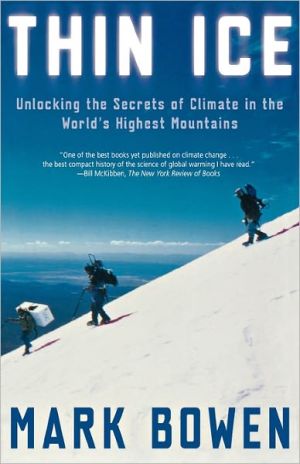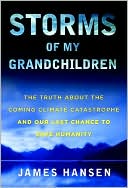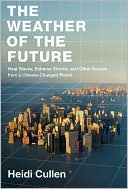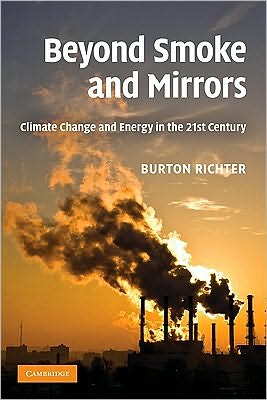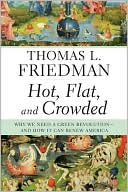Thin Ice: Unlocking the Secrets of Climate in the World's Highest Mountains
"One of the best books yet published on climate change . . . The best compact history of the science of global warming I have read."—Bill McKibben, The New York Review of Books\ The world's premier climatologist, Lonnie Thompson has been risking his career and life on the highest and most remote ice caps along the equator, in search of clues to the history of climate change. His most innovative work has taken place on these mountain glaciers, where he collects ice cores that provide detailed...
Search in google:
While mainstream science has focused on polar ice to find clues about climate change, Lonnie Thompson has been risking his career and life on the highest and most remote ice caps along the equator. In the process he has changed the science of climatology. The idea guiding Thompson's research is deceptively simple: climate is about energy flow, and because the sun's heat enters the atmosphere at the lower latitudes of the tropics, it follows that the equator's mountain glaciers are the ideal place from which to map the course of climate change. Layers of snow that have been laid down year by year can be read like tree rings, providing detailed information about climate history reaching back 750,000 years. The trick is to come up with a safe and reliable method for retrieving and preserving ice cores while living and working for weeks, sometimes months, in what mountaineers call the "death zone," the environment above eighteen thousand feet. Thompson has done just that, and to gather significant data he has spent more time in the death zone than any man who has ever lived. As explorer and expedition leader, Lonnie Thompson occupies that narrow perch on adventure's summit alongside Ernest Shackleton. Scientist and expert climber Mark Bowen joined Thompson's crew on several expeditions, including an eye-opening ascent in East Africa that revealed why the snows of Kilimanjaro will be gone in fifteen years. Bowen also includes an account of the dangerous Huascarán ascent where Thompson's discovery of an unknown type of glacial ice revealed how pieces of the global climate puzzle fit together. Bowen also takes up deep inside retreating glaciers from China and the Tibetan Plateau across South America's Andes and to Africa. Thin Ice explains what Thompson's hard-won data tell us about climate systems that have long perplexed the scientific community. Even more important, we learn what the equatorial ice reveals about global warming and the earth's probably future. Publishers Weekly Residents of Florida and the Gulf Coast have seen an unusually early hurricane season this year. Thousands of people die every month as drought continues to grip Africa. In August 2003, 15,000 people, mostly senior citizens, died in a French heat wave. Popular-science author Bowen shows readers how these events result from climate disruption caused by global warming. Bowen frames his story with the exploits of Lonnie Thompson, a professor at Ohio State who pioneered the study of glaciers near the equator. Thompson challenged and eventually changed accepted beliefs on how climate change occurs with his revolutionary lightweight-coring techniques that draw ice cores from glaciers in South America, on the China-Tibet border and elsewhere. Bowen explains how carbon dioxide and water vapor interact to regulate our planet's thermostat and argues that scientific evidence conclusively shows that use of fossil fuels has accelerated global warming; in our lifetimes, he predicts, the snows of Kilimanjaro will be no more. This book will appeal to mountaineering and climatology buffs, but should be read by everyone concerned about the future of our planet. (Nov.) Copyright 2005 Reed Business Information.
Thin Ice\ PART ITHE SAJAMA EXPEDITION1THE MOUNTAIN GODThe Aymara are descended from the Tiwanaku, a mysterious pre-Incan people who once ruled an empire encompassing most of present-day Chile, Peru, and Bolivia from a city on the shores of Lake Titicaca, an inland sea on the high Altiplano. Like their ancestors, many of today's Aymara revere the snow-covered mountains as gods, for they produce the rare trickles of water that make life possible in this inhospitable land. The Aymara believe water is to the land as blood is to the body—the sacred essence of life and fecundity—and that mountain spirits show their wrath through ferocious storms or by holding the water back, in the sky. In the eerie, looming presence of Sajama, one can understand and even share in this belief.Modern society also treats Sajama with respect. Commercial jets are forbidden from flying overhead, for the mountain's core contains an enormous magnet that may twist the needle of a compass more than twenty degrees away from true magnetic north.When Lonnie Thompson arrived in small Sajama village, a few miles west of the mountain, with twenty-odd scientists, a fleet of outfitters from La Paz, the five Peruvian mountaineers who have supported his high-altitude work for decades, and six tons of equipment, the villagers decided they did not want him disturbing the local deity. Similar visitors from the University of Massachusetts, Lonnie's collaborators, had set up a satellite-linked weather station on the summit the previous year, and the subsequent growing season had been poor. The villagers were afraid alarger expedition might induce more severe retribution. Impassioned negotiations ensued.Bernard Francou remembers the bargaining as the most engaging cultural experience of his six years in Bolivia. It fell to Lonnie to convince the people of Sajama—more baleful an assemblage than any grant review committee back in the States—that his work was relevant to their own lives.He told them that the ice on their mountain could give him information not only about Bolivia's changing climate but also about El Niño, the mysterious change in the weather that visits the Altiplano every two to seven years. Their mountain and their dry vegetable plots, which provide a marginal existence even in the best of years, feel El Niño's effects quite directly.Since it generally appears at around Christmastime, the phenomenon was named for the Christ child by anchovy fishermen living less than a thousand miles northwest of here, in the coastal villages of Peru and Ecuador. They noticed that the cold waters that they fished, normally one of the most productive fisheries on earth, rose in temperature with El Niño, and the anchovy disappeared. This disrupts the entire aquatic food chain and the economy based upon it. Seabirds, which feed off the anchovy and produce the mountains of guano that the local farmers use as fertilizer and export all over the world, disappear as well. And while the sea withholds its bounty, it drives huge thunderheads into the skies above the equatorial coastal plain, normally one of the driest places on earth, producing storms, flash floods, and the occasional deadly landslide.Simultaneously, more than nine thousand miles to the west, New Guinea, one of the wettest places on earth, experiences drought, as do Australia and the Indonesian archipelago. The Asian monsoon generally fails, while, farther west, the Horn of Africa receives torrential rain.El Niño's sister, La Nina, who usually visits on his heels, makes Peru even drier than usual and New Guinea even wetter. This climatic seesaw, which scientists have named the "El Niño/Southern Oscillation," or ENSO, spans the Pacific and has immediate collateral effects nearly everywhere on earth.And ENSO is just one—though perhaps the most notorious—of the myriad oscillations and seesaws known to climatologists. Seesaws and oscillations, either in time or in space—some real, some perhaps imagined and the subject of intense debate—are the basic stuff of climatology. A cycle may span years, as with El Niño, decades, several centuries, or hundreds of millennia. Only a few have El Niño's global reach.To find a particular cycle, a climatologist must generally tease it outfrom among dozens of others. Consider the motion of the sun across the sky, which can change temperature by as much as sixty degrees in a single day; the hourly or weekly changes we call weather; the seasons; subtle changes in our orbit around the sun, having periods of tens or hundreds of thousands of years; sunspots and other cycles in solar output—and all of these have different strengths at different latitudes and longitudes. It's like a kid playing with a yo-yo, bouncing on a pogo stick, in a car on springs, zooming along on a roller coaster—worse, actually.The devastation wrought by the last few El Niños has made the phenomenon a household name in recent years. Its east-west, transpacific seesaw has become relatively well known; but Sajama, in Bolivia, stands at the southern end of a second, lesser-known, north-south seesaw with equatorial Peru. When El Niño brings storms to Peru, Sajama experiences drought; when La Niña brings drought, Sajama receives rain. \ AT THE NEGOTIATING TABLE, LONNIE EXPLAINED THAT IF HE COULD FIND BETTER WAYS to predict the onset and strength of these climatic siblings he might help the people of Sajama choose appropriate crops for the corresponding wet and dry years. For some inscrutable reason, however—perhaps out of caution, for they are not yet entirely confident in their predictions—he and Bernard did not reveal that the Southern Oscillation Index was dropping and an El Niño was on the way.But they did point out that a global change of another sort was taking place, that Sajama's glacier was retreating (as the locals had already observed), and that every glacier in the tropical zone will probably disappear within fifty years. Sajama lies just inside the southern edge of the tropics—the main reason Lonnie wanted to drill there. Its high glacier should outlast the others, which are generally lower and nearer the equator, but the odds are that it, too, will disappear while the children, playing as he spoke in the streets of that village, are still alive. And since Sajama's snow is their primary source of water, its disappearance stands to have a dramatic effect upon their lives.Lonnie happened to have some idea just how dramatic that effect might be. Two ice cores he had recovered fifteen years earlier, on the summit of the Quelccaya massif on the northern Altiplano, in Peru, had shown that climate change had played a major role in the births and deaths of numerous Andean civilizations five hundred and more years ago—the ancestors of these very people among them.Archeologists have long known that the Tiwanaku abandoned their city by the lake shortly after A.D. 1000. They had no written language, and there was no explanation for their demise until the Quelccaya ice coresrevealed that a severe drought had set in on the Altiplano just before the Tiwanaku disappeared. The drought persisted for about four hundred years, and when it withdrew, the first Aymara city-states emerged. Furthermore, the drought commenced about a century after a warm spell began on the Altiplano, and its span coincides with an event that is sometimes called the Medieval Warm Period, in which temperatures in many parts of the world, including northern Europe, rose for about four centuries. Based on this evidence, one might expect the present warming to cause another devastating drought in this arid land.You can tell just by looking that the people of the Altiplano are tough—not threatening, strong in the face of adversity. The Aymara of today grow the same crops, tuned to the Altiplano's cold, dry climate, that the Tiwanaku farmed more than a thousand years ago: tubers like potato, oca, olluco, and mashwa, and the unique, cold-adapted grains quinoa and caniwa. Their way of life and animist belief system have withstood the Incas, the Spanish conquistadors, and—at least until now—the lure of the city. But a few bad years might change that. Already El Alto, the slum by the airport on the Altiplano above La Paz, is swelling from a steady trickle of migrants across the high, windswept plain. \ WHEN THE SCIENTISTS FINALLY WORKED OUT A DEAL WITH THE PEOPLE OF SAJAMA, A delegation from the village joined them at base camp to conduct a ceremony similar to those that had taken place ten and more centuries earlier in the city of Tiwanaku. They gathered together in a circle around a bonfire and passed around an endless supply of coca and legía, chasing them with shots of grain alcohol. (One scientist testifies that his head went completely numb.) Two yatiri, or holy men, offered songs and prayers to Sajama and Pacha Mama ("Lady Earth"), seeking fertility for their families and fields and forgiveness for the transgressions they planned. Lastly, the yatiri laid a white llama on a smooth stone, used before for this purpose, and slit its throat. They spilled blood, the magic elixir, into a ritual ceramic cup. Singing songs and scattering figurines of humans and animals in the fire, they sprinkled the animal's blood on the sand.Lonnie reached the summit two days later.Copyright © 2005 by Mark Bowen
Prologue : a call from the blue1Pt. IThe Sajama expeditionPt. IIEarly daysPt. IIIThe warming sets inPt. IVThe essence of lifePt. VMore pieces for the puzzlePt. VIKilimanjaro
\ From the Publisher"Amusing and entertaining . . . Thin Ice is at the same time a scientific biography, a fine introduction to the sciences of climate change and a vivid description of a geophysicist's work under most extreme conditions."—Nature\ \ \ \ \ Publishers WeeklyResidents of Florida and the Gulf Coast have seen an unusually early hurricane season this year. Thousands of people die every month as drought continues to grip Africa. In August 2003, 15,000 people, mostly senior citizens, died in a French heat wave. Popular-science author Bowen shows readers how these events result from climate disruption caused by global warming. Bowen frames his story with the exploits of Lonnie Thompson, a professor at Ohio State who pioneered the study of glaciers near the equator. Thompson challenged and eventually changed accepted beliefs on how climate change occurs with his revolutionary lightweight-coring techniques that draw ice cores from glaciers in South America, on the China-Tibet border and elsewhere. Bowen explains how carbon dioxide and water vapor interact to regulate our planet's thermostat and argues that scientific evidence conclusively shows that use of fossil fuels has accelerated global warming; in our lifetimes, he predicts, the snows of Kilimanjaro will be no more. This book will appeal to mountaineering and climatology buffs, but should be read by everyone concerned about the future of our planet. (Nov.) Copyright 2005 Reed Business Information.\ \ \ Library JournalIn 1997, Bowen was contacted by a magazine editor looking for a science writer with climbing experience to join paleoclimatologist Lonnie Thompson on his expedition to drill ice cores on the summit of Bolivia's highest mountain. Retrieving ice cores, which are read like tree rings and present detailed information about climate history, requires that climatologists spend weeks, even months, working in the "death zone," the area above 18,000 feet. Here Bowen, who accompanied Thompson on several more expeditions, documents the specialized techniques that Thompson used to extract and preserve ice cores from the highest mountains around the world's equator while also examining Thompson's research, which is based on the provocative premise that equatorial mountain glaciers, rather than polar ice, provide the clues to understanding global warming. Bowen chronicles the global warming debate from its earliest predictors up to the present and notes the undeniable fact that temperatures have noticeably risen over the past 50 years, with the high latitudes experiencing the fastest warming. Bowen and Thompson believe that the snows of Kilimanjaro will disappear within the next 15 years, evidenced by its already retreating glaciers. Both a gripping adventure tale that will appeal to armchair mountaineers and a serious science account, this timely book is highly recommended for all academic and larger public libraries.-Gloria Maxwell, Penn Valley Community Coll. Lib., Kansas City, MO Copyright 2005 Reed Business Information.\ \ \ \ \ Kirkus ReviewsMountain-climbing journalist Bowen accompanies researchers as they dig atop glaciers at the Earth's equator and gives an in-depth report on the field of climatology. Lonnie Thompson has long been a towering figure in the world of climate science. Once seen as an iconoclast who had a wild idea about studying the ice near the planet's equator, he's now acknowledged to be a visionary in the field. With his dramatic, low-budget, seat-of-the-pants trips to the glaciers of Africa, China and South America, Thompson makes a great character for Bowen to fashion a book around. But while the author starts off trying to weave in hard science with tales of Thompson drilling ice in sub-zero temperatures, transferring core samples in hot-air balloons, this is ultimately a history of the science, covering climatology's beginnings and citing projections for the near future. (Mt. Kilimanjaro won't have its snows much longer, the author notes.) Bowen is deeply concerned about global warming-with the weather patterns that the Earth has seen and will likely experience in the future and the many players large and small who have contributed to the understanding of how humans are changing the planet's atmosphere. The author intersperses stories of Thompson's treks with discussions of scientific infighting, congressional debates, struggles for funding, the health and history of the Earth's atmosphere and on and on. The work's structure bears a passing resemblance to Moby-Dick, part adventure tale, part densely annotated guide to Thompson's profession. Bowen covers an enormous amount of ground in impressive, accessible detail. For those interested in global warming, the hard facts, backed by prodigious amount ofinvestigation, will be most welcome. A tremendous work of research, with plenty of entertaining adventure and colorful characters to boot.\ \
